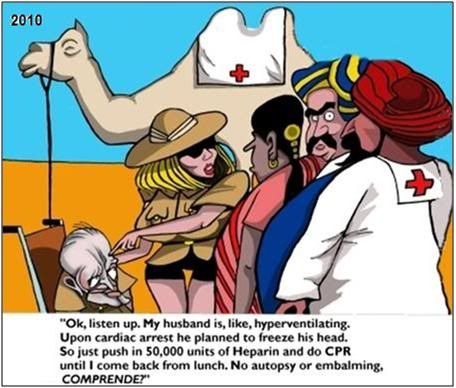By Mike Darwin
 Some years ago, Aschwin de Wolf pushed me very hard to do a blog. We actually got to the point where, due to Aschwin’s efforts, the site was set up on WordPress, and I had done some sandbox “posts.” However, I didn’t follow-through, in large measure because I felt the blog format was not suited to what cryonics really needed from me, and needed in general, in terms of a working group and recruitment tool. For my part, I have a lot of technical, philosophical and historical information that I believe is important to the future of cryonics, and which must be disseminated globally – literally around the world. Some of this information is material I’ve written, but much of it isn’t – or is a transmission through me, of the wisdom and knowledge of others; many of whom are no longer able to speak for themselves.
Some years ago, Aschwin de Wolf pushed me very hard to do a blog. We actually got to the point where, due to Aschwin’s efforts, the site was set up on WordPress, and I had done some sandbox “posts.” However, I didn’t follow-through, in large measure because I felt the blog format was not suited to what cryonics really needed from me, and needed in general, in terms of a working group and recruitment tool. For my part, I have a lot of technical, philosophical and historical information that I believe is important to the future of cryonics, and which must be disseminated globally – literally around the world. Some of this information is material I’ve written, but much of it isn’t – or is a transmission through me, of the wisdom and knowledge of others; many of whom are no longer able to speak for themselves.
The definition of a blog is “a frequently updated personal journal chronicling links at a Web site, intended for public viewing.” While the Comments section of Chronosphere might approach that in character, the “blog” itself consists of long pieces of often technically dense information, as well as shorter, more topical posts. Most importantly, the real mission of Chronosphere is to attract some of best minds in the world, and to provide a vehicle for them to contribute to the growth, and to the ultimate success of cryonics. To achieve that end, a group of like minded and morally compatible people must come together and work together. What I am saying here, is that while it has the software format of a blog, Chronosphere is not meant to be the sphere of discourse of any one man.
 Information and communications technology are evolving so fast at this time that old models of technologically mediated communication are disintegrating, morphing, and developing new forms and nuances, almost as fast as the passing months go by. In their day, Cryonics Magazine and CryoNet were the best mechanisms available for communicating information, building community, and motivating newcomers to become involved in cryonics. These two vehicles are now as limited, and therefore as obsolete, as the ox-drawn cart.
Information and communications technology are evolving so fast at this time that old models of technologically mediated communication are disintegrating, morphing, and developing new forms and nuances, almost as fast as the passing months go by. In their day, Cryonics Magazine and CryoNet were the best mechanisms available for communicating information, building community, and motivating newcomers to become involved in cryonics. These two vehicles are now as limited, and therefore as obsolete, as the ox-drawn cart.
While it was not used for transport in the New World, Mesoamerican civilizations had invented the wheel; they used it as a toy – a mechanism to allow children to pull little figures around, mounted on tiny carts. Beyond that, the wheel was useless to them in part, because the rocky and overgrown terrain of the jungles in which they lived and in which they built their impressive civilizations, was unsuited for the creation of roads. People often call the Internet the “Information Super Highway.” This couldn’t be more wrong. While it is “super,” it is nothing like a 2-dimensional, fixed-path road, or highway. It is fundamentally different – as different as a 3-dimensional, dynamically rewire-able mammalian brain is from a 1-dimension circuit board. That means that it will have lots of powerful and perilous new emergent properties.
If we cryonicists want to survive into the indefinite future, we have to be willing to own that future, or die trying. That means not just mastering, but artfully using the best of these emerging technologies (in all spheres of endeavor) to further our survival. And where there is no “perfect fit” for our needs, well then, we need to create a new space that meets our needs. So, what I am saying here is that while the WordPress blog format is an “easy entry” way to begin this effort, it isn’t a last stop, and really, it isn’t even a proper “first step.” It’s also important to point out that Chronosphere, from the start, has not been the effort of just one man. It came about due to the efforts of Eugen Leitl, Aschwin deWolf, and Brian Wowk. Since then, Steve Bridge has pitched in, and a number of cryonicists have begun posting intelligent and productive things in the Comments section.
 Mike Darwin, at right.
Mike Darwin, at right.
But this not enough, not nearly enough! There is a massive amount of work literally sitting around waiting to be done…and beyond all that catching up with the past, there is a vast amount of challenging and exciting new work needed.
Cryonics has lost touch with cryonics – and this is neither a joke, nor a play on words. There are a stack of nearly 20 books on my desk here that deal with cryonics – some in very interesting and important ways. They need to be reviewed, and not just reviewed, but commented upon, and put into context. I find it astonishing that some of the people who are mentioned in, or are significant subjects of these books have not reviewed them. And yes, I include in this category everything from lie-packed trash, like Larry Johnson’s Frozen: My journey into the World of Cryonics, Death and Deception, to thoughtful and interesting narratives like Brian Alexander’s, Rapture: How Biotech Became the New Religion. There are at least a dozen more – and that doesn’t include novels.
The penetration of cryonics into the popular culture has succeeded to an extent that was simply unimaginable to those of us who labored to get Alcor 2.0 going in 1981. And we’re not just talking generalities here. Consider the two cartoons in Figure 1, below. We were overjoyed to see this kind of humor in 1968 and in 1990, because it told us a number of important things about our efforts to communicate the idea of cryonics to the culture. It told us that our message was getting through, on at least two levels. The first level was to the slightly ‘off center’ and cynically funny people who create cartoons. These people are two things, at a minimum; smart and observant. To the extent they are successful, they have to be able not just to inform the public about a funny or bizarre idea, they have to be able to know exactly how the public will react to that idea. A good cartoonist is thus a “psychic channeler” of public opinion and zeitgeist. Some part of Richard Nixon’s fall can be rightly attributed to the cartoonists of the time.

Figure 1: At left, above, a cartoon which appeared in the major national US weekly photojournalism magazine LOOK, and at right, a cartoon from 1990 by Gary Larson, from his Far Side series.
The 1968 cartoon (above, left), as simple as it seems, is incredibly nuanced, and it reflects a concern on the part of the population at that time that would not likely be as much of an issue now; principally what happens to the soul, when you are cryopreserved? How funny would a cartoon be showing a patient in deep hypothermic circulatory arrest, or undergoing CPR with the same theme today? Think about these facts: CPR had been invented by Peter Safar in 1960, only eight years before that cartoon appeared in LOOK magazine, the first mass citizen training in CPR was still 4 years away, and the Uniform Determination of Death Act did not become law until 1978, a full decade later. We’ve come a long way since then.
The 1990 Gary Larson cartoon is less nuanced, but it clearly shows that the idea of neurocryopreservation has made it into the cultural mainstream. Before he retired, Gary Larson was arguably the most popular cartoonists in the US.
Now, have a look at the two cartoons below, from 2006 and 2010, below. The first one may seem run of the mill, until you look at it closely – really closely. The name on the cryopatient’s drawer is MERKLE. Similarly, the cartoon from 2010 instructs the (presumably) North African onlookers, one of whom is a medic, to “push 50,000 units of heparin and do CPR…”

Figure 2: A close inspection of the cartoon above reveals a much deeper layer of meaning, not apparent at first glance, and one that is only meaningful to a very few people in the whole of the global culture.
 Figure 3: The details in this cartoon are revealing, and tell us things about our effectiveness in communicating with the culture, as well as a little about how the culture is reacting to that message.
Figure 3: The details in this cartoon are revealing, and tell us things about our effectiveness in communicating with the culture, as well as a little about how the culture is reacting to that message.
This shows a remarkable change, principally much increased specificity and detail in the message that is being pinged back to us. I don’t think any of us in 1981 could imagine that kind of change in the culture. And while it seems that we are not (apparently) making any headway in terms of the culture’s attitude towards cryonics, analysis of the “signal” in this data, shows that we really do have the detailed attention of these two humorists, and that’s impiortant. They didn’t stop at the meta-concept of cryonics; they went a level, or perhaps a number of levels deeper. And they got it right; Ralph Merke is indeed (unfortunately) one of the most readily identified spokespersons for cryonics as a scientific enterprise, and yes, 50,000 units of heparin is absolutely correct, and so is the injunction to start CPR to circulate it. None of these details is essential to communicate the humor intended by the cartoonists, and in the case of the 2006 cartoon, it is irrelevant to all but a tiny segment of the population that the name on the freezer drawer is “Merkle.”
 Figure 3: What should we make of Futurama? Is it silliness and satire, or is there a message in the medium?
Figure 3: What should we make of Futurama? Is it silliness and satire, or is there a message in the medium?
That’s the sort of analysis we need of the popular culture; and keep in mind this is only the tip of the iceberg, so to speak (pun intended). There are the spheres of music, computer gaming, and other areas of the arts where cryonics has penetrated, and where there will inevitably, or at least likely, be important implications for us. Some of this material I can’t even understand, such as NVIDIA’s Cryostasis video game: http://cryostasis-game.com/ – and it’s not just because I’m too old (which I am), but because I’ve never had the kind of mind that could grasp, let alone enjoy, that kind of entertainment. Other perspectives are thus essential if we want to communicate with the full spectrum of the population (and we do).
So, for openers, we need Columnists on Chronosphere who will track the popular culture, review books, and systematically identify novel technologies that could be of benefit to cryonics, both long term, and much more importantly, now. Feature articles are also needed – good quality, thoughtful articles on every aspect of cryonics, with an emphasis on the practical and near term, or better still, on ways to improve our position here and now. It may be premature for me to be asking for this kind of participation so soon after the launch of Chronosphere. If so, I’ll do it again, and again, and again, until the time is right.
I must also confess that I don’t know how long it will take to recruit these invaluable human resources. In the 1970s, when Steve Bridge and I started Cryonics magazine after LongLife magazine folded, it took several years before we started getting consistent, high quality input. I’m hopeful that the ongoing technological transformation in communication will shorten this interval – if for no other reason than because I’m personally fast running out of time. But that may be unrealistic, because while technological advance has sped the pace of mass communication dramatically, it has also fragmented it. That is both good and bad. On the upside, it has given voice to a lot of formerly voiceless people. On the downside, the silence of many of those folks was arguably a blessing.
The rise of blogs, Facebook and Twitter, have unquestionably de-focused intelligent dialogue, and raised the noise to signal ratio to nearly impossible levels. In the past, there were very substantial barriers to an individual disseminating his ideas to the world. It cost money to print and mail broadsheets, newsletters and magazines, and it was arduous to turn ideas into printed words, let alone to illustrate and format them! Now, if I have something to say, I can (and literally am) writing the equivalent of a 110 page book a week – and doing the illustrations and the layout alone – incredible! I shudder to think what kind of output the late Isaac Asimov would have, were he alive today? Perhaps it is just as well he loathed cryonics and decided to opt out of the future?
 But what technology giveth, it also so often taketh away. The good part of those “barriers” to publication were that first of all, only people who really wanted to communicate their message, would do so. That was huge and largely positive filter – none of us wants to live in a world where every idle thought has more gravitas than the sleaziest published writers of the 20th century. Because publication and dissemination of writing was so expensive in the past, most writing was processed through newspapers and publishing houses. That meant they were subjected to scrutiny, editing and review, all of which are decidedly unpleasant things to writers, but which are a nearly unalloyed blessing to readers. In this era of the blog, and of instantaneous, unedited and virtually no-cost publication of writing, it is hard to know if a filtered communication mechanism like Chronosphere can prosper. I guess we’ll find out in due course.
But what technology giveth, it also so often taketh away. The good part of those “barriers” to publication were that first of all, only people who really wanted to communicate their message, would do so. That was huge and largely positive filter – none of us wants to live in a world where every idle thought has more gravitas than the sleaziest published writers of the 20th century. Because publication and dissemination of writing was so expensive in the past, most writing was processed through newspapers and publishing houses. That meant they were subjected to scrutiny, editing and review, all of which are decidedly unpleasant things to writers, but which are a nearly unalloyed blessing to readers. In this era of the blog, and of instantaneous, unedited and virtually no-cost publication of writing, it is hard to know if a filtered communication mechanism like Chronosphere can prosper. I guess we’ll find out in due course.
In the meantime, I ask you to consider contributing to this effort to a build a new world; yes, yet again, a new world – but this time, one we can live in.

You’ve been doing a great job on this information repository so far Mike. Reading through it has been like a breath of fresh air. I take it you are open for contributions?
“I take it you are open for contributions?”
Hell yes, get busy! — Mike
so you are trying to say that cryonics is going somewhere? After more than 40 years, you have only 1200 sign ups? Sorry, that is a failure, plain and simple. Cryonics has been rejected, defeated by the body of the culture, like an invading virus. Cryonics is the most audacious idea in human history, and it should have attracted tons of sign ups. But it has not. A failure. The thing speaks for itself. Out of a base target pool of 400 million english speaking people, and cryonics gets 1200? After more than 40 years? A failure.
The culture has defended itself against cryonics, and very successfully.
Your culture references here only show that cryonics is known to the public, and that even so, they have rejected it. You try to pass off a failure as a success!
No, I am most emphatically not trying to say cryonics is a success. Indeed, much of what I have written here, and the “300+ pages” of my “Failure Analysis Lectures,” should make it abundantly clear that I in no way think (and can in no way reasonably be accused of thinking, or stating) that cryonics has been a success.
Having said that, success comes in phases, and it also has perquisites. For now, forget about the “phases” part of the previous sentence and focus on the “perquisites” part. The iPad is widely regarded as a success, as is Coca Cola. Both of these products require that the public know and understand what they have to offer. This may seem so obvious as to hardly merit attention. In fact, it requires a lot of attention, so much so that in the case of Coca Cola, which is a well established and unique product, they still spend tens of millions of dollars on advertising. Despite its success, the iPad is still a niche market device when considered in the context of the overall market for that kind of device. To get the full benefit of the market, Apple will have to much better educate people about the iPad, and use emotion-based marketing (“I HAVE to have that”) to sell more iPads; and that will cost a lot of money. The relevance of these examples is that despite the fact that these are both mature and developed products that work right now, which people fully understand the purpose of, and which few would argue are “evil” or “dangerous,” these companies still have to work very hard to market them, and to sustain their market position. And, these products are proven to make money, so it is easy to get capital to market them.
Yes, cryonics has failed. But has it failed completely? The answer there is demonstrably, “not quite, and not yet” That is very important, because it tells us a number of things:
1) While the culture did not embrace cryonics, it did not react as you describe – far from it. If the culture had violently rejected cryonics like an invading organism, cryonics would be long gone. The proof of that is not just that cryonics exists in some places, but also that it has been banned by law in some other places, most notably British Columbia in Canada, and France. That is rejection – and under no circumstances should that be mistaken for indifference, or mild irritation.
2) In most of the West and Russia, cryonics has been ignored. This has happened for many reasons, which I’m not going to go into now. For this, we should be very grateful, given the danger that cryonics represents to this culture. They don’t “get it” and that is a laudable state of affairs compared to their “getting it,” and squashing it like a bug.
3) What cryonics and cryonics organizations have succeeded in doing is really quite remarkable, in a way. They have manged to achieve absolutely enormous cultural penetration of the idea with essentially no money, and without (so far) provoking an “immune response” of any consequence. In fact, it gets better, because most people in the culture 30 or under, are no longer willing to dismiss cryonics out of hand: few would say it is impossible. That is a sea change from 1964, or even 1984, and it is due to technological advance in the life sciences making the ideas underpinning cryonics seem more reasonable, as well as due to efforts on the part of cryonics organizations.
4) There can be no success in marketing anything without awareness of in the marketplace that the product exists, what it is useful for, and how it works. In the case of a dissonant and disturbing idea, the longer it is around and it is understood how it works without it causing harm or upset, the better (to a point). A truly fantastic amount of dollar value has been achieved at very little cost in terms of educating the public about the “basics” of cryonics: it exists, what it is supposed to do, and how it works.” When you see a cartoon with a caption that says “push 50,000 units of heparin and start CPR,” well that’s education of the culture to an extent that Apple would pay millions for – and in fact does.
5) Finally, and most importantly, we do not want the culture to embrace us, rather we want to subsume the culture. Part of “The von Braun Error,” was to get the culture to embrace space travel as a technology, rather than as value-driven philosophy. Look where it got him, and more importantly where it got the philosophy of universal human diaspora and space travel. The vicious cretins running the culture took von Braun’s rockets, tipped them thermonuclear weapons, spent a significant fraction of the West’s and the Near East’s GDP on it for decades, and has damned near killed us all in the process – and may kill us still!
The take home message: Only a fool gives children or psychopaths (1) firearms or matches to play with. Our mission is not just to “sell” cryonics to the culture. That would be a very foolish exercise, indeed. It is also unlikely to work (in part, because it hasn’t worked so far!). Rather, our objective is to overthrow the culture, taker control of it, and in the process cryonics will become the norm. Ambitious? Of course, but such revolutions are accomplished with frequency in human history, sometimes for good, sometimes for ill. — Mike Darwin
1) Unless they are legal residents of the state of Arizona in the US.
Interesting that you should bring up the iPad, Mike. I’ve started to read about telemedical apps for smart phones and tablet PC’s. It looks as if the iPad stands poised to become the main IT platform for health care. Some major medical schools now assign them to their students as part of their training:
http://www.imedicalapps.com/2011/03/ipad-beat-android-tablets-hospital-medical-use/
As for, “our objective is to overthrow the culture, taker control of it, and in the process cryonics will become the norm,” no doubt you would know of “Hayekian” arguments against that sort of ambition: Societies develop in organic ways, resist efforts at social engineering, change in a “drunkard’s walk” fashion because “progress” towards a more rational state doesn’t exist despite the wishful thinking of the Enlightenment, etc. Would you care to address these objections?
I’ll be posting an article, I hope soon, entitled “I know this going to come as a shock,” which should explain the iPad reference.
I’m very tired right now, and heading to bed. So all I’ll say about your remarks re “getting control of the culture” for now, is this. If you mean am I proposing some top down Comintern kind of rule, imposing things in some “planned” way, the answer is no; it won’t work, not yet anyway, because it simply isn’t possible to get the required information (and process it centrally) to allow for good decision making. The example you should think on is the American Revolution (which the British, to this day, refuse to call that – and consider nothing more than a political-economic squabble). In fact, it was a true revolution; while it built on the Magna Carta, it also fundamentally altered the culture. You might say it was the final realization of the schism between church and state – something that has not yet happened in the Islamic world. Christianity was every bit as nasty as Islam BEFORE Martin Luther and the American Revolution. All you need to do is to read Tom Paine, Jefferson, Adams and the Federalist Papers, to understand that a VERY SMALL group of men got control of the whole damn apparatus of power, and overthrew the existing political culture. That revolution has made the monarchies of the West vestigial things. The Royal Family in the UK is like the Disney franchise, with the added benefit that the Queen makes no decisions, and yet she IS Britain’s public face. Thus she can be a goodwill ambassador, whilst the government takes a dump on the people she’s visiting and glad handing. Very clever, really, and the money that flows in from tourism is phenomenal.
So, think of it in those terms. Nazism, Maoism and Leninism are negative examples, up to a point. Mao, the worst monster of the lot, in terms of the number killed, was arguably good for China at the time, given their other problems. It’s complicated, and you are quite right to point out that if I, or anyone else, thinks we can specify where all the bubbles will be in the cake, or even what flavor it be, let alone how it will be iced, all before we bake it – well, that would be crazy. All we can hope for is that we get a cake, instead a of a tub of cyanide-laced KoolAid. There’s no getting around the weirdness and explosive and unpredictable nature of recursive systems.
One last point. We are entering new territory. Jefferson, Adams, and all the other were MOTRAL – they died. And the transmission of their values has been greatly diluted and corrupted by generational turns over. Practical immortality will alter that arc of affairs. Similarly, the speed at which the culture can now be revamped is nothing short of staggering; LOOK at that Michel, et al., article carefully. It’s a whole new ballgame, and I intend that we be amongst the first, if not the first to understand and exploit those changes in how the game can be played. — MD
Why is it unfortunate that Ralph Merkle is one of the most readily identified spokespersons for cryonics as a scientific enterprise?
we do not need people like merkle to go on tv and talk up cryonics, although I used to believe just that.
We need people who go to church and fix cars and work as accountants and mechanics and who live in flyover country and the suburbs. When we get people like THESE on tv talking up cryonics, we will be on our way. But when we get people like we currently have as spokespeople, that is when we get only 12oo signups after 40+ years.
I don’t know what to make of Ralph Merkle.
On the one hand, the National Inventors’ Hall of Fame has just inducted him, which puts into the company of inventors like Ray Kurzweil and Dean Kamen:
http://www.invent.org/2011induction/1_3_11_induction_merkle.asp
On the other hand, what has he really accomplished to deserve the honor? For a skeptical view of his career, refer to:
http://mthollywood.blogspot.com/2006/04/who-is-ralph-merkle-i-ralph-merkle-is.html
http://mthollywood.blogspot.com/2006/04/who-is-ralph-merkle-ii-although-merkle.html
http://mthollywood.blogspot.com/2006/04/who-is-ralph-merkle-iii-steve-edwards.html
Merkle is an uber-geek, and therefore exactly the wrong kind of people who need to be fronting Alcor on tv etc. We need salt of the earth types with families, who go to church, who work as carpenters etc. We need Joe and Jane Sixpack. These folks outnumber the type who find merkle impressive 10,000 to 1.
When our membership (and fronting folks) is composed primarily of ordinary people like this, cryonics membership will number in the million(s). But before we can attract people like this, cryonics has to be seen as ordinary, and in line with the norms of american culture. But look at the people who are now attracted to cryonics–far from ordinary. Why?
Why why why?
“So the whole question of public key encryption has, so far, turned out to be academically interesting, but not especially useful in the real world.”
John Bruce doesn’t see the value of online banking?